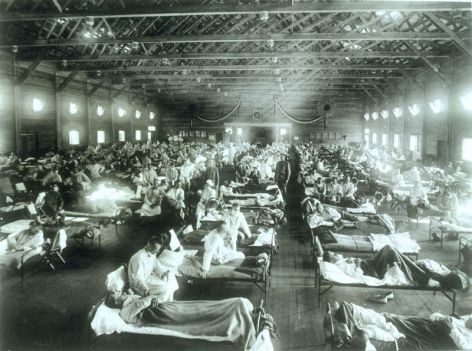Will the Influenza Outbreak Get Worse?
It’s the 100th anniversary of the deadly 1918 flu pandemic, and 2018 has begun with a serious flu epidemic. What does the Bible prophesy about diseases in the end time?

Achoo! Cough!
Both of these are signs that we may have the dreaded influenza virus, commonly known as the flu. We may start off just feeling miserable, with a cough and runny nose, then develop more serious symptoms such as a sore throat, fever, body aches and total exhaustion.
Most people associate the flu with a week or so in bed then bouncing back to regular life. But some years the flu is more serious. Several media outlets have reported about the severe flu season we are having, and many nations are bracing for it to get worse:
- Already “Moderately Severe,” Flu Season in U.S. Could Get Worse.
- “Aussie Flu” Is “More Severe Than the Swine Flu” Pandemic of 2009 Which Killed Nearly 300,000 People Across the World, Expert Warns.
- NHS Fears the Worst Flu Season in History.
- Number of Flu Patients Rises in Japan With 1.24 Million New Cases Reported in First Week of the Year.
It is appropriate to take the flu seriously. This year, 2018, should be a reminder of just how serious an influenza outbreak can become.
A reminder of how bad it can get
This is the 100th anniversary of the 1918 flu pandemic, the deadliest pandemic in modern history. It was responsible for the deaths of 20 to 50 million people, and it infected an estimated 500 million people worldwide—one-third of the world’s population at that time.
U.S. soldiers with the Spanish influenza at Camp Funston, Kansas (1918).
When the influenza virus mutates, it spawns new variants of the virus. Since the population will not have immunity to the new virus, it can spread rapidly. Sometimes it can even affect otherwise healthy young adults. That’s what happened in 1918.
Influenza is particularly difficult for scientists to produce vaccines for. The Popular Science website called the virus “a sneaky little devil” because of its tendency to mutate so that even recently developed vaccines can be ineffective against it. A flu virus can mutate so fast that by the time it spreads from one country to another, it can already be a different variant.
Disease in prophecy
In Revelation 6 we read about the infamous four horsemen of the Apocalypse. These horsemen symbolize four trends that exist today but will intensify during the end times. Each horse has a specific color and symbol, with a meaning that is explained further by looking at Matthew 24. The white horse symbolizes religious deception; the red horse, warfare; the black horse, famine; and the pale horse, death. To learn more about the connection between Revelation 6 and Matthew 24, read “Four Horsemen of the Apocalypse: What Are They?”
Consider the pale horse. After famine, Jesus Christ mentioned pestilences—disease epidemics (Matthew 24:7). This is the only horse whose rider is given a name: “Death” (Revelation 6:8). The Greek word translated “pale” is chlōros, a greenish color, likely describing either a sickly appearance or the color of decaying flesh.
This horse is also connected to “the beasts of the earth” (Revelation 6:8). A surprising fact is that 75 percent of emerging infectious diseases are transmitted from animals to humans. In recent years we have seen swine flu (from pigs), avian flu (from birds) and Ebola virus (from primates).
If a similar pandemic occurred in our time, it would be far worse because of how interconnected our world is and how close people live together in urban areas.
Revelation 6:8 says, “Power was given to them over a fourth of the earth, to kill with sword, with hunger, with death, and by the beasts of the earth.” It’s possible that a large percentage of those deaths will be caused by disease.
Consider the 1918 flu pandemic that killed 50 million people. It came at the end of World War I, the most destructive war to date. The flu killed far more people than the war did. It wiped out entire families and left countless widows and orphans.
The impact was especially devastating because over half of those who died were younger working-age adults in the prime of their lives. This, in turn, had a major impact on the economy as businesses were forced to shut down because of the lack of labor and decreased markets. Basic services like mail delivery and garbage collection were hindered, and even food supplies were affected because not enough people were available to harvest crops.
If a similar pandemic occurred in our time, it would be far worse because of how interconnected our world is and how close people live together in urban areas.
A rising new order
Jesus describes these intensifying trends as the “beginning of sorrows” (Matthew 24:8). So in addition to the devastation and death already caused by horrible tragedies, there is more yet to come. It’s not hard to imagine the chaos that will arise when one in four people die. We have seen the chaos that has arisen when a major natural disaster has struck, bringing about looting, vandalism, rioting and a general lawlessness. We can expect an environment of fear where every man fends for himself.
Out of all this chaos, a new power will arise in Europe, led by a charismatic leader called the “beast” in the Bible. It’s possible that he will attain power by promising to restore order and normalcy. But his rule will contribute to greater suffering. It will get so bad that “unless those days were shortened, no flesh would be saved” (Matthew 24:22).
The good news is that those days will be shortened. Christ will intervene and establish His government on earth. His rule will be the dawn of a new world where sickness and pestilence will be a thing of the past. The prophet Malachi wrote that “the Sun of Righteousness shall arise with healing in His wings; and you shall go out and grow fat like stall-fed calves” (Malachi 4:2, emphasis added).
To learn more, read “MERS Outbreak in America: Is the Pale Horse Beginning to Gallop?” and “Ebola Outbreak: A Dress Rehearsal for the ‘Big One.’”
Date Posted: January 26, 2018



